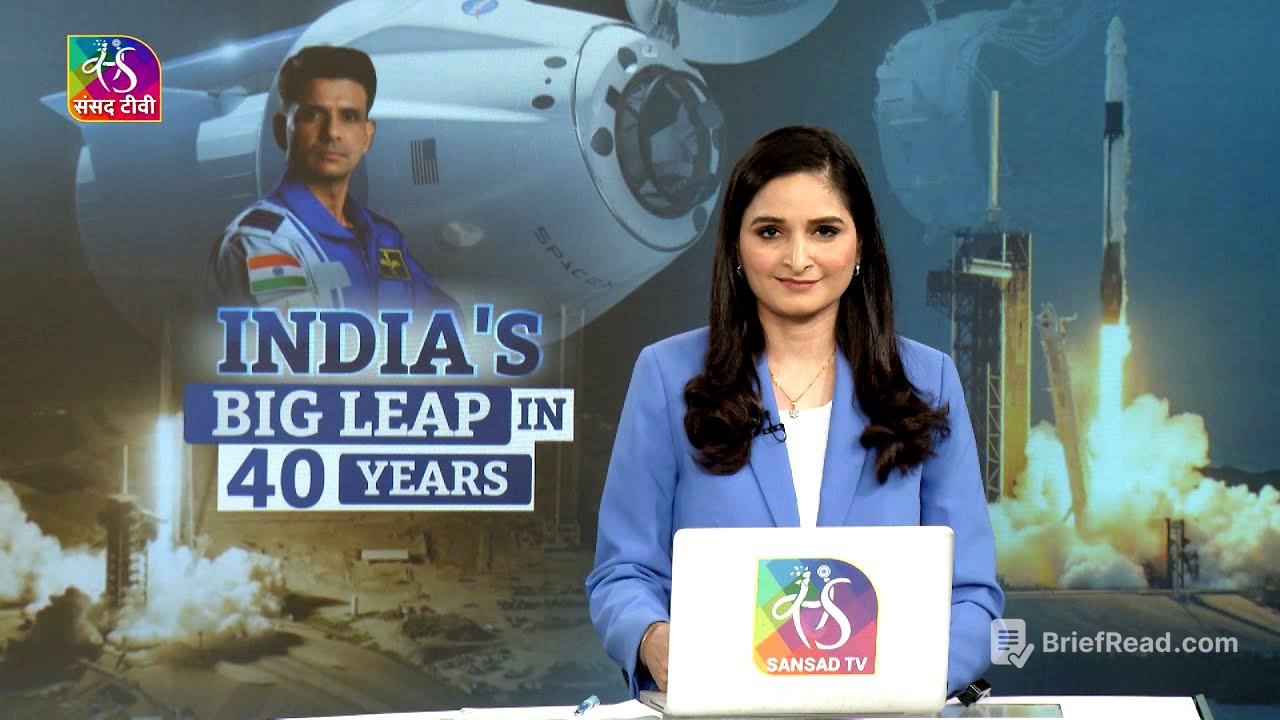TLDR;
This video discusses the significance of India's return to human spaceflight after 40 years with the AX4 mission, which sent Group Captain Shoubhan Shukla to the International Space Station. The mission is viewed as a crucial step for India's space program, especially in preparation for the Gaganyan mission and future lunar missions. Experts discuss the importance of international collaboration, the nature of experiments conducted on the ISS, and the potential long-term benefits for India's space capabilities and global standing.
- India's return to human spaceflight after 40 years.
- AX4 mission as a stepping stone for Gaganyan and future lunar missions.
- Importance of international collaboration and indigenous capabilities.
- Experiments on ISS focusing on human health in space and potential for space manufacturing.
- Long-term benefits for India's space program and global standing.
Introduction [0:00]
The host introduces the topic of India's return to human space flight after 40 years with the AX4 mission, which successfully launched from NASA's Kennedy Space Center. Group Captain Shoubhan Shukla is now the second Indian in space, following Rakkesh Sharma in 1984. The mission, led by NASA astronaut Peggy Witson, includes astronauts from Poland and Hungary and will spend 14 days on the ISS conducting about 60 scientific experiments. The discussion will cover the mission's significance for India's space ambitions and its impact on the Gaganyan program.
Significance of AX4 Mission [2:32]
Dr. Go emphasizes the significance of the AX4 mission, noting that unlike Rakkesh Sharma's flight, this mission directly informs India's Gaganyan program. The timing is opportune as human space flight costs decrease and lunar missions become the next focus. The use of reusable rockets like Falcon 9 has reduced space flight costs by 95%, potentially enabling space tourism. Dr. Raju highlights India's rapid progress in space exploration, from having virtually no planetary science program in 1993 to becoming a top space-faring nation with lunar and Mars missions.
India's Space Journey and Collaboration [5:57]
Dr. Raju discusses India's 50-year journey in space, from the first satellite launch in 1975 to developing its own launch vehicles and satellites. He emphasizes the importance of international collaboration in space technology due to its high costs, citing the International Space Station as a five-country collaboration. The AX4 mission will provide valuable insights into surviving and developing habitats in space, particularly on the moon, where water ice has been discovered. Experiments on the mission include growing food in space, aiming for self-reliance in sustaining life beyond Earth.
Influence on ISRO's Future Plans [9:58]
Dr. Raju explains that Shuban Shukla's participation in the AX4 mission provides him with firsthand experience that will be invaluable for the Gaganyan mission, for which he is already earmarked as an astronaut. This experience extends beyond technological advancements to include healthcare solutions and motivating young scientists and engineers. Dr. Go discusses the importance of international partnerships in space exploration for accessing specific capabilities, but stresses the need for India to develop its own capabilities to execute missions independently. He clarifies that the AX4 mission is more of a commercial arrangement than a true international collaboration.
Experiments on the ISS [13:06]
Dr. Go explains that experiments on the ISS typically focus on the effects of space and weightlessness on the human body, such as muscle and calcium loss. These experiments aim to understand and mitigate these effects for long-duration missions like those to Mars. Other experiments explore how biological and physical systems behave differently in space, potentially leading to advancements in cancer treatment and manufacturing processes. ISRO has planned seven experiments for Group Captain Shoubanu Shukla, focusing on human-machine interaction and gathering feedback applicable to the Gaganyan mission.
ISRO's Experiments and Long-Term Goals [15:53]
Dr. Raju details some of the experiments planned for Shukla, including growing high-protein sprouts and fenugreek (matey) in space to generate food. Other experiments involve manufacturing specific materials in a clean, microgravity environment for medical applications. He mentions experiments on tardigrades to understand survival techniques in harsh environments and studies on muscle loss and bone health in space. These experiments aim to gather firsthand information for future missions, including Gaganyan and lunar habitats, focusing on food production, radiation survival, and physical health.
Astronaut Training and India's Space Capabilities [19:25]
Dr. Raju notes that Shukla's mission is a step beyond Rakkesh Sharma's, as he will pilot the Dragon spacecraft and interface with the ISS. This experience will be invaluable for future indigenous development and maneuvering of spacecraft, including potential space walks. He mentions the analog space station in Ladak, which simulates space conditions for testing components and training astronauts. This preparation is crucial for physical and mental readiness, simulating the isolation and challenges of space travel.
India's Position in the Global Space Race [23:41]
Dr. Go emphasizes that a large part of India's human space flight program involves engineering and hardware development, ensuring systems are reliable and integrated perfectly. He highlights the exclusivity of the "space club," with fewer than five countries having human space flight capability. This capability will be crucial for future space activities like lunar bases, mining, and tourism. Dr. Raju notes India's progress in space capsule recovery experiments and plans for future missions like Chandrean 4, which will bring back samples from the moon. He reiterates the importance of human space programs and the need to align with other space-faring nations.
Future of India's Space Program [25:51]
Dr. Raju states that India has made major strides in space, particularly in astronomy, communication, and remote sensing missions. He emphasizes the significance of the human in space program (HSP) and India's leap into this domain through the AX4 mission. He hopes that the experiments conducted by Shuban Shukla will yield rich data and inspire future generations. He mentions the importance of connecting the Dragon spacecraft with the ISS and the safe return of the astronauts as crucial steps. The mission includes plans for Shukla to interact with academia and students, encouraging them to become future astronauts and scientists.









